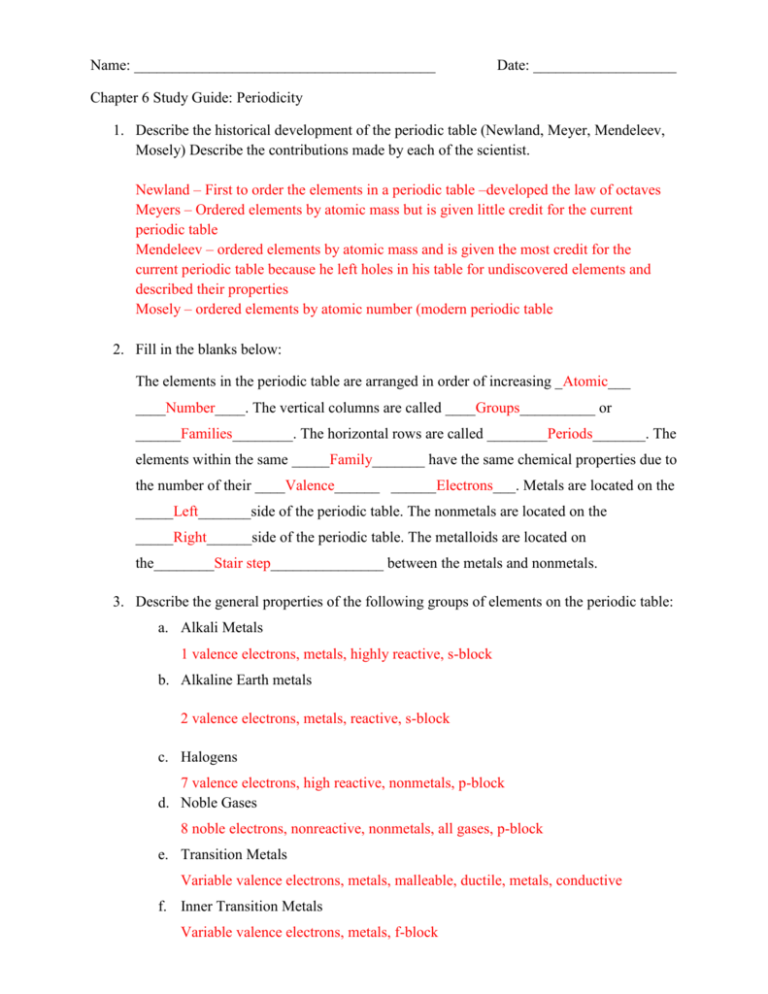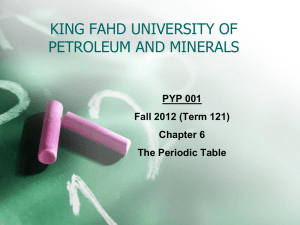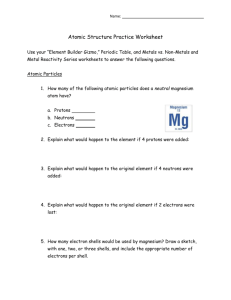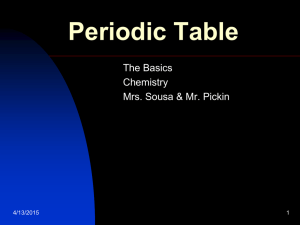chapter 6 study guide with answers
advertisement

Name: ________________________________________ Date: ___________________ Chapter 6 Study Guide: Periodicity 1. Describe the historical development of the periodic table (Newland, Meyer, Mendeleev, Mosely) Describe the contributions made by each of the scientist. Newland – First to order the elements in a periodic table –developed the law of octaves Meyers – Ordered elements by atomic mass but is given little credit for the current periodic table Mendeleev – ordered elements by atomic mass and is given the most credit for the current periodic table because he left holes in his table for undiscovered elements and described their properties Mosely – ordered elements by atomic number (modern periodic table 2. Fill in the blanks below: The elements in the periodic table are arranged in order of increasing _Atomic___ ____Number____. The vertical columns are called ____Groups__________ or ______Families________. The horizontal rows are called ________Periods_______. The elements within the same _____Family_______ have the same chemical properties due to the number of their ____Valence______ ______Electrons___. Metals are located on the _____Left_______side of the periodic table. The nonmetals are located on the _____Right______side of the periodic table. The metalloids are located on the________Stair step_______________ between the metals and nonmetals. 3. Describe the general properties of the following groups of elements on the periodic table: a. Alkali Metals 1 valence electrons, metals, highly reactive, s-block b. Alkaline Earth metals 2 valence electrons, metals, reactive, s-block c. Halogens 7 valence electrons, high reactive, nonmetals, p-block d. Noble Gases 8 noble electrons, nonreactive, nonmetals, all gases, p-block e. Transition Metals Variable valence electrons, metals, malleable, ductile, metals, conductive f. Inner Transition Metals Variable valence electrons, metals, f-block 4. Identify the classes of elements to which the following elements belong. Each element is described by using more than three terms from the following list: Metal, nonmetal, metalloid; alkali metal, alkaline earth metal, transition metal, inner transition metals, halogens, noble gas; solid liquid and gas (at room temp) a. Argon: ___Nonmetal, noble gas, gas __________________________ b. Arsenic: ___Nonmetals, n/a, solid_________________________ c. Mercury: ___metal, trans metal, liquid________________________ d. Phosphorus: __nonmetal, n/a, solid_____________________ e. Magnesium: ____metal, alkaline earth metal, solid___________________ f. Sulfur: ___nonmetal, n/a, solid________________ g. Potassium: ___metal, alkali metal, solid_______________________ h. Copper: ____metal, trans metal, solid___________________________ 5. Define Cation and Anion. How are each of these ions made? Cation – positive ions, electrons are lost Anion – negative ions, electrons are gained 6. What types of elements on the periodic table (metals, nonmetals, metalloids) are going to form cations? Metals 7. What types of elements on the periodic table (metals, nonmetals, metalloids) are going to form anions? Nonmetals 8. What are the charges of the following families when they form ions? a. Alkali Metals ____+1______ b. Alkaline Earth metals ___+2______ c. Boron Family ____+3_____ d. Carbon Family ____±4_____ e. Nitrogen Family ___-3______ f. Oxygen Family ___-2______ g. Halogens ___-1______ h. Noble Gases __0_______ 9. What are the charges for the following elements? Classify them as cations or anions: A. Calcium ___+2 Cation B. Nitrogen ___-3 anion C. Iodine ___-1 Anion D. Lithium ____+1 cation E. Sulfur ___-2 Anion F. Aluminum ___+3 cation G. Krypton ____0 N/A H. Carbon ___±4 Either 10. Define the following terms: a. Periodicity – Trends recurring at intervals on the periodic table b. Atomic Radius – half the distance between two nuclei of atoms bonded together c. Ionization Energy – The amount of energy to remove an electron d. Electronegativity – The ability to attract electrons in a bond e. Periodic Law – Period repetition of chemical and physical properties of elements 11. Explain in detail the following: a. What is the trend for Atomic Radius going down a family? Why? Increases because energy levels (rings) are being added so the size increases. b. What is the trend for atomic radius going across a period left to right? Why? Decreases because the number of protons increases and will pull the electrons in tighter c. What is the trend for ionization energy going down a family? Why? Decreases because the energy levels increases causing electron shielding meaning the nucleus is not holding on to the electrons as tightly making it easier to remove electrons d. What is the trend for ionization energy going across a period left to right? Why? Increases because the number of protons increases holding onto the electrons tighter making it harder to remove an electron. e. What is the trend for electronegativity going down a family? Why? Decrease because the energy levels increase causing electron shielding causing the pull of the nucleus on the electrons weaker. f. What is the trend for electronegativity going across a period left to right? Why? Increases because the number of protons increases causing the pull of the nucleus on the electrons to be stronger 12. Arrange the following elements in increasing atomic radii: calcium, bromine, arsenic, gallium Br, As, Ga, Ca 13. Arrange the following elements in increasing atomic radii: Potassium, cesium, lithium, rubidium Li, K, Rb, Cs 14. Arrange the following elements in order of increasing first ionization energy: Rubidium , xenon, strontium, tin, iodine Rb, Sr, Sn, I, Xe 15. Arrange the following elements in order of increasing first ionization energy: Aluminum, Indium, boron, gallium In, Ga, Al, B 16. Arrange the following in order of increasing electronegativity: beryllium, nitrogen, carbon, fluorine Be, C, N, F 17. Arrange the following in order of increasing electronegativity: iodine, chlorine, bromine, fluorine I, Br, Cl, F








